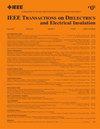A Method of Kernel Principal Component Analysis and Machine Learning Algorithms for Fault Diagnosis of Power Transformers
IF 3.1
3区 工程技术
Q2 ENGINEERING, ELECTRICAL & ELECTRONIC
IEEE Transactions on Dielectrics and Electrical Insulation
Pub Date : 2025-02-20
DOI:10.1109/TDEI.2025.3543337
引用次数: 0
Abstract
As one of the most important equipment in the power system, it is of great significance to conduct fault diagnosis research on transformers. Aiming at the problem of difficult selection of parameters for support vector machine (SVM) in transformer fault diagnosis, a fault diagnosis model based on the improved pelican optimization algorithm (IPOA) optimized SVM is proposed. First, the standard pelican optimization algorithm (POA) is enhanced by introducing the Tent chaotic mapping, Levy flight strategy, and adaptive weighting strategy, and the superiority of the IPOA algorithm is verified by comparing its performance with other intelligent algorithms across four test functions. Second, feature dimensionality reduction of the data samples is performed using kernel principal component analysis (KPCA), and the IPOA algorithm is used to optimize the SVM parameters and then establish the transformer fault diagnosis model based on IPOA-SVM. Finally, the POA-SVM, northern goshawk optimization (NGO)-SVM, GWO-SVM, whale optimization algorithm (WOA)-SVM, and particle swarm optimization (PSO)-SVM models are used to conduct comparative experiments with the proposed method. The results show that the diagnostic accuracy of the IPOA-SVM model reaches 95%, which is 3.75%, 5.0%, 6.25%, 7.5%, and 8.75% higher than that of the POA-SVM, NGO-SVM, GWO-SVM, WOA-SVM, and PSO-SVM diagnostic models, respectively; and the proposed model exhibits better stability and greater adaptability.电力变压器故障诊断的核主成分分析与机器学习算法
变压器作为电力系统中最重要的设备之一,对其进行故障诊断研究具有重要意义。针对支持向量机(SVM)在变压器故障诊断中参数选择困难的问题,提出了一种基于改进的鹈鹕优化算法(IPOA)优化支持向量机的故障诊断模型。首先,通过引入Tent混沌映射、Levy飞行策略和自适应加权策略,对标准鹈鹕优化算法(POA)进行了增强,并在四个测试功能上与其他智能算法进行性能比较,验证了IPOA算法的优越性。其次,利用核主成分分析(KPCA)对数据样本进行特征降维,并利用IPOA算法对SVM参数进行优化,建立基于IPOA-SVM的变压器故障诊断模型;最后,利用POA-SVM、北苍鹰优化(NGO)-SVM、GWO-SVM、鲸鱼优化算法(WOA)-SVM和粒子群优化(PSO)-SVM模型与所提方法进行对比实验。结果表明:IPOA-SVM模型的诊断准确率达到95%,分别比POA-SVM、NGO-SVM、GWO-SVM、WOA-SVM和PSO-SVM诊断模型高3.75%、5.0%、6.25%、7.5%和8.75%;该模型具有较好的稳定性和适应性。
本文章由计算机程序翻译,如有差异,请以英文原文为准。
求助全文
约1分钟内获得全文
求助全文
来源期刊
CiteScore
6.00
自引率
22.60%
发文量
309
审稿时长
5.2 months
期刊介绍:
Topics that are concerned with dielectric phenomena and measurements, with development and characterization of gaseous, vacuum, liquid and solid electrical insulating materials and systems; and with utilization of these materials in circuits and systems under condition of use.

 求助内容:
求助内容: 应助结果提醒方式:
应助结果提醒方式:


